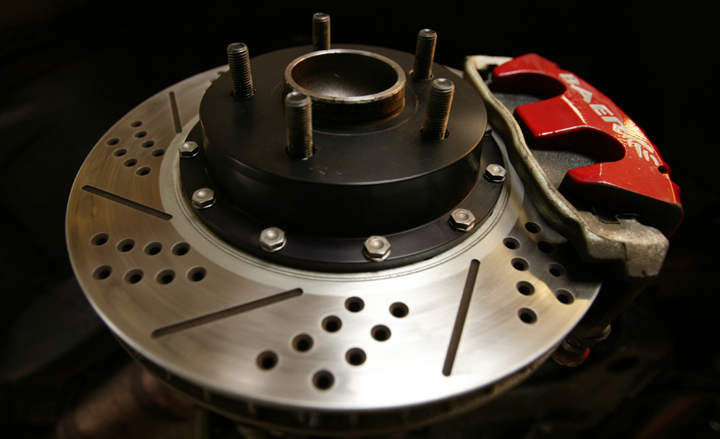Seasoning your brake rotors is an essential part of preparing your brake system for heavy-duty or high-performance braking.
In the interest of keeping yourself safe and maximizing the life of your brake rotors, completing a thorough seasoning procedure after installing your new rotors is strongly recommended.
You should season your brake rotors before bedding in your brake pads. Though the two procedures are relatively similar, they are done for different reasons.
Where bedding your brake pads is about properly transferring pad material to your rotors and cooking out resins used in the brake pad manufacturing process, seasoning your brake rotors is about burning machine oils from the rotor surface and establishing a wear pattern between the pad and rotor. Most importantly, seasoning your rotors is about relieving internal stresses within the metal that makes up your rotor. (Read How to Choose Aftermarket Brake Rotors here.)
The experts at Baer compared it to pouring water into a glass of ice and seeing the ice crack as a result. That is internal stress in action.
“By gradually heating the material, the crystalline matrix will reconfigure to relieve these internal stresses,” according to Baer’s online tech center. “After these stresses are relieved, the rotor is ready to accept the heat of bedding pads. Heating the rotors before they are fully seasoned can result in material deformation due to the unrelieved internal stresses in the material. This deformation may cause a vibration from the brakes.”
[warning]NOTE: Please do NOT test performance or attempt heavy use of your brakes until the following steps have been taken. [/warning]
How to Season Brake Rotors
From the mad geniuses at Baer
1. Use the vehicle for five or six days of gentle driving, using the brakes to the same extent you would in typical driving conditions.
[important]NOTE: Zinc-plated rotors require a couple extra days of driving to wear through the plating before the rotor-seasoning process can begin.[/important]
2. After finding a safe location to drive your vehicle as fast as 70 miles-per-hour, perform four regular stops—from 60-70 miles-per-hour down to complete stops as you would during normal driving conditions.
3. Next, perform medium-effort partial stops (about 50 percent) from 60 miles-per-hour down to about 15 miles-per-hour. Once completed, drive for five minutes with little to no braking, allowing your rotors to cool.
4. Next, perform four medium- to hard-effort partial stops (about 75 percent), from 60 miles-per-hour down to about 15 miles-per-hour. Once completed, drive for 10 minutes with little to no braking, letting your rotors cool.
5. Park the car and let your brakes cool overnight. According to the experts at Baer, you’re now 50-percent complete with the seasoning process. To finish the job, you’re going to essentially repeat the procedure from the day before.
6. Return to your safe location for driving as fast as 60 miles-per-hour. Next, perform medium-effort partial stops (about 50 percent) from 60 miles-per-hour down to about 15 miles-per-hour. Once completed, drive for five minutes with little to no braking, allowing your rotors to cool.
7. Next, perform four medium- to hard-effort partial stops (about 75 percent), from 60 miles-per-hour down to about 15 miles-per-hour. Once completed, drive for 10 minutes with little to no braking, and let your rotors cool off.
8. Finally, make six hard partial stops, from 60 miles-per-hour down to about 15 miles-per-hour. Make every effort to perform these stops without locking your wheels. When you’re done, drive for 10 minutes with little to no braking, allowing your rotors to cool.
9. One more time, park your car and let your brake system cool overnight. If you just installed new brake pads as well, you are now ready to bed-in your brake pads. You can read our How to Bed-In Brake Pads post here.


[…] Note: Do not try to bed-in brake pads without seasoning your rotors. Also, when bedding your pads, give yourself a substantial coast-down zone that will give you […]
[…] How to Season Brake Rotors […]
I can honestly say I’ve never gone this far in settling in a new set of brakes!
Thanks 4 the FYI
Can you season rotors and bed in pads simultaneously? There seems to be overlap in the two processes.
Hey Larry, the short answer is no. And though we were prepared to write the long answer here too, our pals over at Baer Brakes did a much better job:
…
Click here to read Baer’s insight on Rotor Seasoning and Pad Bedding.